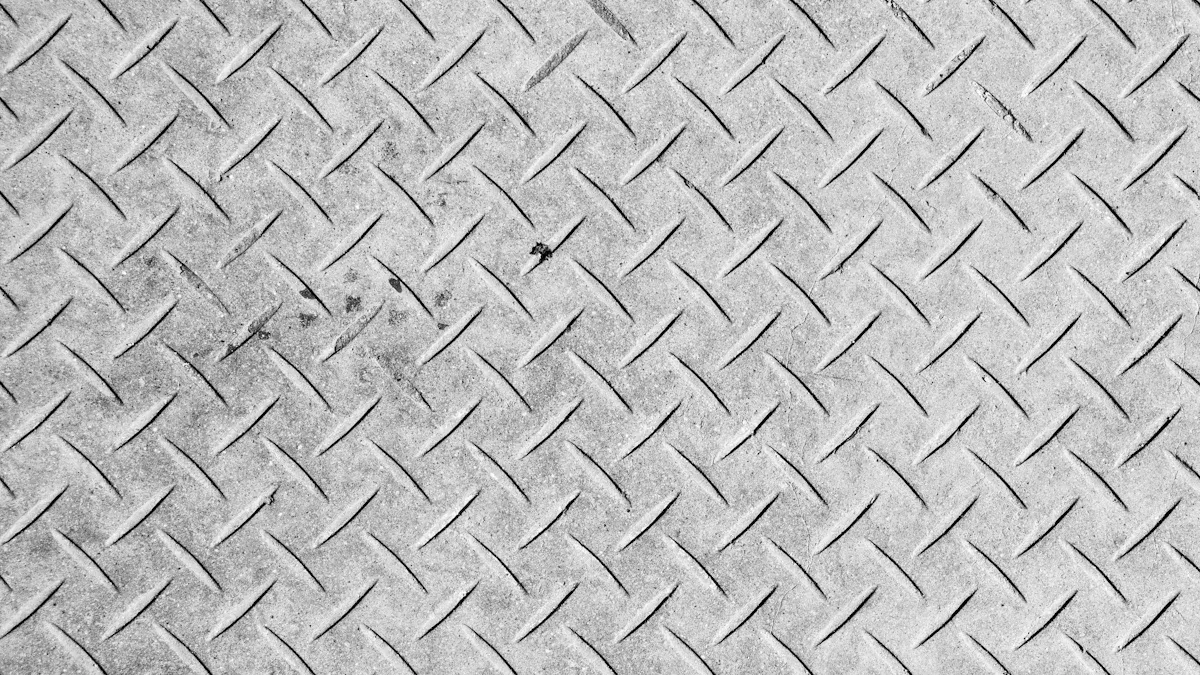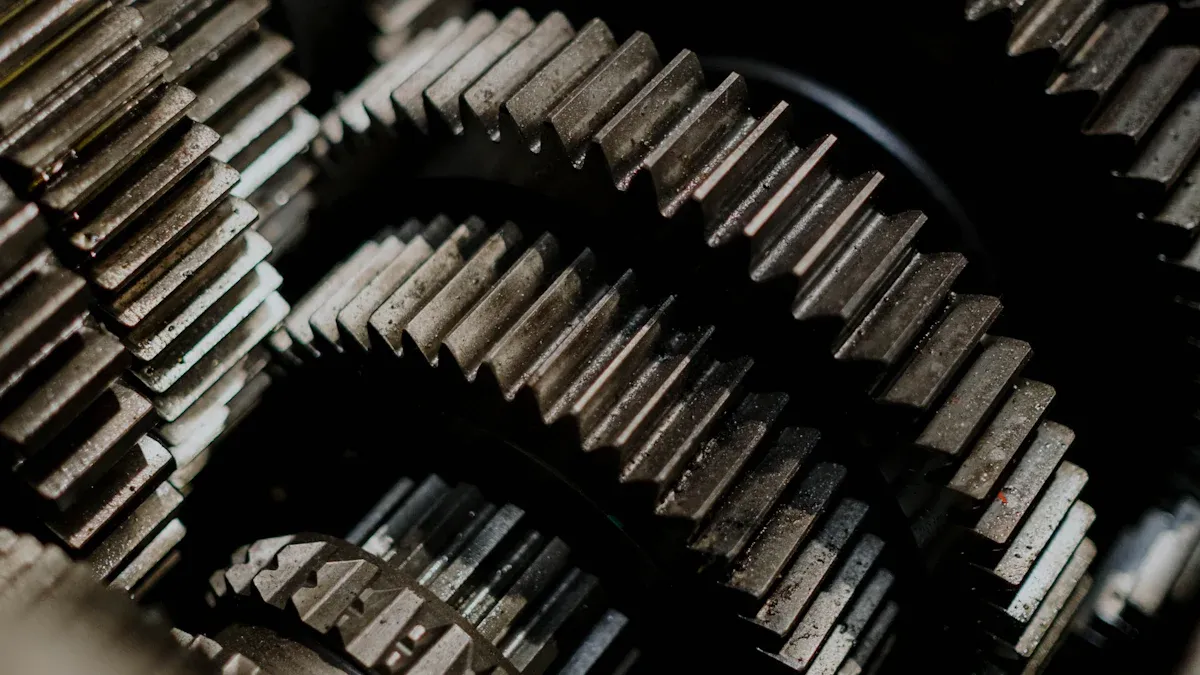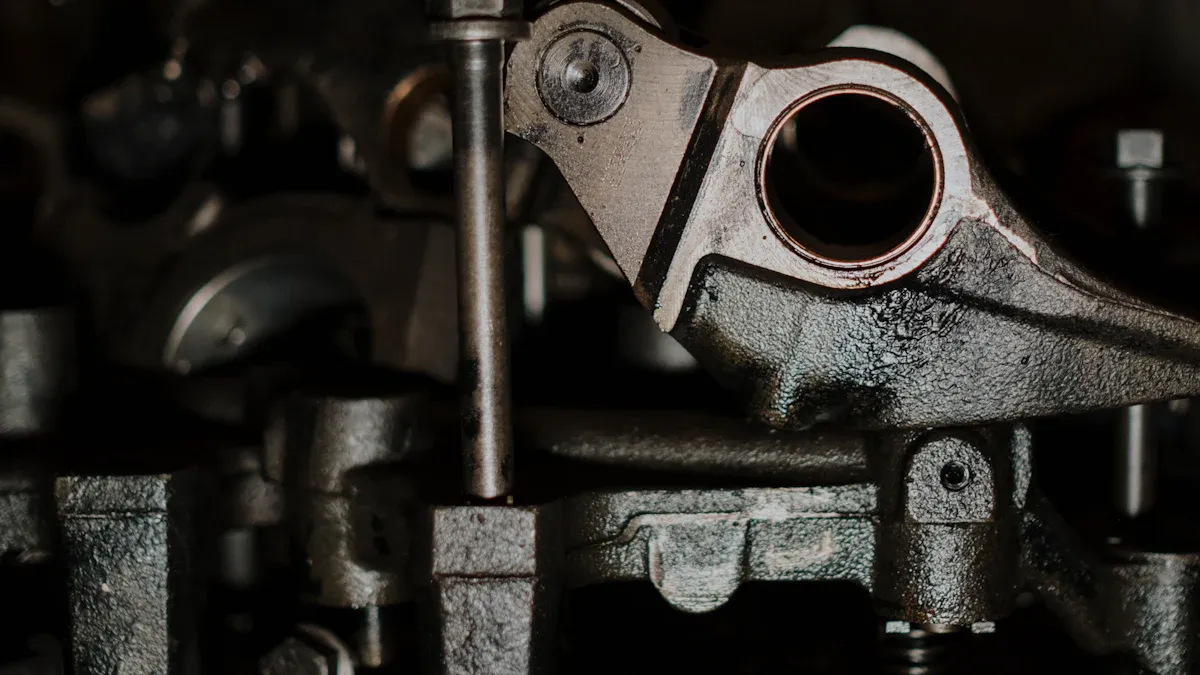
Wear-resistant parts are components designed to endure friction, pressure, and wear over time. These parts play a key role in preserving the performance and extending the lifespan of machinery, tools, and equipment. By resisting abrasion and damage, they reduce costs and improve efficiency across industries.
You encounter wear-resistant materials daily, whether in non-stick cookware or high-performance plastic parts. Their importance goes beyond convenience. Studies show that abrasion accounts for up to 4% of a nation’s gross national product, emphasizing the need for durable solutions. In industries like construction and aerospace, wear-resistant steel plates enhance machinery longevity while minimizing downtime.
Wear-resistant parts are designed to withstand the effects of friction, pressure, and mechanical wear. These parts help reduce material loss caused by repeated rubbing, sliding, or scraping. This property, known as wear resistance, ensures that components maintain their shape and functionality over time.
In engineering, wear-resistant parts play a vital role in systems where two surfaces move against each other. Bearings, gears, and rotating shafts are just a few examples. By minimizing friction, these parts improve efficiency and reduce the need for frequent replacements. The study of wear, friction, and lubrication, known as tribology, helps engineers develop the best wear-resistant materials for various applications.
| Aspect | Description |
|---|---|
| Definition | Wear resistance is the ability of a material to resist the progressive loss of volume from its surface through mechanical actions such as repeated rubbing, sliding, or scraping. |
| Importance in Engineering | Wear-resistant parts are critical in applications where two load-bearing surfaces slide over one another, such as in bearings, wear pads, gears, and rotating shafts. |
| Role of Tribology | The principles of wear, friction, and lubrication are studied in tribology, which focuses on the interaction between surfaces in relative motion. |
You encounter wear-resistant parts in many aspects of life. In industries, they are essential for maintaining the performance of heavy machinery and equipment. For example, conveyor belts in factories rely on wear-resistant materials to handle constant movement and heavy loads. Similarly, cutting tools in manufacturing use coatings to stay sharp and effective.
In daily life, wear-resistant parts make everyday items more durable. Shoe soles, for instance, are made from materials that resist abrasion, ensuring they last longer even with regular use. Non-stick cookware is another example. Its coating prevents food from sticking while also resisting scratches and wear.
Case studies highlight the importance of wear-resistant parts in industrial settings. For instance, a platinum mine reduced pump repair frequency by using a high-resistance coating. In another example, a coal power plant saved $33,000 in maintenance costs by applying wear-resistant epoxy coatings. These examples demonstrate how the best wear-resistant materials can save money and improve efficiency.
| Case Study/Report Title | Description | Link |
|---|---|---|
| The Top Four Types of Wear Impacting Industrial Equipment | Discusses various types of wear affecting industrial equipment and the role of coatings like Devcon in mitigating these issues. | Link |
| Devcon® Wear Guard™ 300RTC High Chemical Resistance Coating Reduces Pump Repair Frequency at Platinum Mine | Case study on how a specific coating reduced repair frequency in a mining application. | Link |
| Devcon® Wear Guard™ Fine Load Saves Coal Powerplant $33,000 in Pump Repair Costs | Case study showing cost savings from using wear-resistant coatings in a coal power plant. | Link |
By using wear-resistant parts, you can extend the lifespan of tools, equipment, and everyday items. Whether in industrial machinery or hou sehold products, these parts ensure durability and cost savings.
Wear-resistant materials are specifically engineered to endure friction, pressure, and mechanical wear. These materials play a critical role in ensuring the longevity and performance of components. Their unique properties, such as hardness and low friction, help reduce material loss during operation.
In engineering, the effectiveness of wear-resistant materials is often measured using key metri
cs like Pressure (P) and Velocity (V). The product of these two factors, known as PV, determines how well a material can handle operational conditions. For example:
- A higher PV value indicates better performance under load.
- The coefficient of friction (COF) also influences wear rates, as lower COF values reduce resistance to sliding.
Testing methods for wear-resistant materials involve subjecting them to controlled friction and pressure. Engineers calculate wear thickness by measuring the mass of the material before and after testing. This ensures accurate and reliable results.
| Material Type | Wear Thickness (mm) | Comparison Ratio to Wear-Resistant Material |
|---|---|---|
| New Wear-Resistant Material | 0.1314 | 1.0 (baseline) |
| 16 Mn Steel | 1.6232 | 12.35 times greater than new material |
| Ordinary Carbon Structural Steel | 0.9612 | 7.32 times greater than new material |
The table above highlights how wear-resistant materials outperform traditional options like steel. By choosing the best wear-resistant materials, you can significantly extend the lifespan of components.
The durability of wear-resistant parts depends on several mechanisms. These include the material's ability to resist thermal reactions, its microstructure, and its interaction with other surfaces. Research shows that wear resistance is not solely determined by hardness. Instead, it involves a combination of atomic interactions and thermal stability.
Computational tools help scientists simulate how materials behave under stress. These simulations reveal how atomic structures influence macroscopic properties like wear resistance. By understanding these mechanis ms, engineers can design alloys with superior wear-resistant properties.
For example, coatings like ES302 for roller bearings enhance durability by reducing adhesive wear. This coating acts as a dissimilar material to steel, preventing direct contact between surfaces. In real-world applications, bearings with ES302 coatings last over 2,000 hours compared to just 200 hours for uncoated bearings. Laboratory tests confirm that these coatings can extend bearing life by up to six times under standard conditions.
Wear-resistant coatings and treatments improve the performance and lifespan of components. These solutions are tailored to specific applications, considering factors like thickness, durability, and environmental resistance.
| Coating/Treatment | Thickness (µm) | Durability | Corrosion Resistance | Aesthetic Options |
|---|---|---|---|---|
| Powder Coating | 50-150 | Excellent | Best | Most Color Options |
| PVD | 0.5-5 | Extremely High | Moderate | Limited Options |
| Nitriding | 5-50 | Moderate | Moderate | N/A |
| Parkerizing | 5-50 | Moderate | Moderate | N/A |
| Black Oxide | N/A | Limited | Limited | N/A |
Powder coating, for instance, offers excellent durability and corrosion resistance, making it ideal for outdoor applications. PVD (Physical Vapor Deposition) provides extremely high durability in thin layers, often used in cutting tools. Nitriding enhances surface hardness, while Parkerizing and Black Oxide offer moderate protection for specific uses.
The design of wear-resistant coatings goes beyond applying a harder material. It involves understanding the interaction between materials, geometric characteristics, and environmental factors. This comprehensive approach ensures optimal performance and durability in various applications.

You encounter wear-resi stant parts in many household items. Non-stick cookware is a great example. Its special coating prevents food from sticking and resists scratches, making it last longer. Shoe soles also use wear-resistant plastics. These materials protect the soles from wearing out quickly, even with daily use.
Another example is smartphone cases. Many cases are made from wear-resistant plastics to protect your phone from scratches and drops. These everyday items show how wear-resistan t parts improve durability and save you money over time.
Industries rely heavily on wear-resistant parts for high-wear applications. Conveyor belts in factories, for instance, handle heavy loads and constant movement. They use wear-resistant materials to prevent tearing and abrasion. Cutting tools in manufacturing also benefit from wear-resistant coatings. These coatings keep the tools sharp and effective, even after repeated use.
Abrasion resistance testing plays a key role in evaluating these parts. Industries benchmark their performance against standards like ASTM or ISO to ensure they meet strict requirements. This process guarantees that the materials can handle high-wear applications without failing.
Wear-resistant parts are essential in vehicles. Brake pads and engine c omponents are two critical examples. Brake pads made from wear-resistant materials last longer and improve safety. Engine components, such as pistons, use wear-resistant plastics to reduce friction and extend their lifespan.
Tests show that new brake components often last as long as the car itself. For example:
- A car may need only one new brake disc over its lifetime, compared to 2.5 standard discs.
- Similarly, 16 new brake pads may be required, while standard pads need 14 replacements.
| Benefit | Description |
|---|---|
| Improved Safety and Reliability | Reduces the risk of accidents and recalls. |
| Early Identification of Design Flaws | Saves time and money by improving product quality. |
| Enhanced Performance and Lifespan | Reduces repairs and replacements, increasing vehicle value. |
These examples highlight how wear-resistant parts improve performance and reduce costs in the automotive industry.
Wear-resistant parts play a crucial role in improving industrial efficiency. By reducing friction and wear, these parts help machinery operate smoothly for longer periods. This minimizes downtime and ensures consistent production. For example, manufacturers are now using advanced wear resistant materials to lower rolling resistance in tires. A 10% reduction in rolling resistance can save 1-2% on fuel costs annually. This translates to $12-$24 in savings for every vehicle, while the additional cost of these tires is only $1-$2 per year.
Safety is another significant benefit. Wear-resistant parts reduce the risk of equipment failure, which can lead to accidents. Industries that rely on heavy machinery, such as mining and construction, benefit greatly from these durable components. By using the best wear resistant materials, companies can enhance workplace safety while cutting costs on repairs and replacements.
| Evidence Type | Description |
|---|---|
| Fuel Savings | A 10% reduction in rolling resistance saves 1-2% on fuel costs annually. |
| Cost Implication | Additional tire costs are minimal, leading to net savings for consumers. |
| Research Focus | Manufacturers are innovating to balance wear resistance and performance. |
Wear-resistant parts contribute to a more sustainable future. By lasting longer, these parts reduce the need for frequent replacements. This means less waste ends up in landfills and fewer raw materials are consumed during production. For example, industries that use wear resistant materials in conveyor belts or cutting tools experience fewer breakdowns. This reduces the demand for new parts and lowers the environmental footprint of manufacturing processes.
Additionally, the energy required to produce and transport replacement parts decreases when durable components are used. This helps conserve resources and reduces greenhouse gas emissions. By choosing wear-resistant solutions, you not only save money but also help protect the planet.
Investing in high-quality wear-resistant parts offers significant long-term value. These parts often last up to 30% longer than cheaper alternatives. This reduces maintenance costs and minimizes production interruptions. For businesses, proactive management of wear-resistant components can prevent unplanned downtime, which can cost over $250,000 per hour in manufacturing operations.
The market for wear-resistant parts is also growing rapidly. With a projected compound annual growth rate (CAGR) of 5-7% over the next five years, industries are increasingly recognizing the value of durable components. This growth reflects the rising demand for infrastructure and industrial activities. By using the best wear resistant materials, businesses can stay comp etitive while enjoying reduced costs and improved productivity.
| Evidence Description | Key Insight |
|---|---|
| High-quality wear parts last 30% longer | Reduces maintenance costs and production interruptions. |
| Proactive management improves productivity | Prevents unplanned downtime, saving up to $250,000 per hour in operations. |
| Expected CAGR trends for wear parts sector: 5-7% | Indicates strong market growth driven by industrial and infrastructure needs. |

Choosing the right wear-resistant parts starts with understanding the specific requirements of your application. The mechanical properties of the materials, such as hardness, elasticity, and toughness, play a critical role. For example, harder materials may resist abrasion better, but they might lack the flexibility needed for certain applications.
Environmental factors also influence material performance. Some materials excel in humid or corrosive environments, while others perform better in dry or high-temperature conditions. For instance, stainless steel offers good corrosion resistance but may not match the durability of platinum-gold alloys in extreme conditions. Cost and availability are equally important. While premium materials like platinum-gold alloys provide exceptional performance, they come at a higher price.
| Material Type | Wear Resistance | Corrosion Resistance | Cost Comparison |
|---|---|---|---|
| Platinum-Gold Alloys | 100 times more durable than high-strength steel | Excellent, suitable for harsh chemical environments | Higher cost, but justified by performance |
| Stainless Steel | Good, but less durable than platinum-gold alloys | Good, varies by alloy composition | Generally lower cost, but less performance in extreme conditions |
Evaluating the quality of wear-resistant parts ensures you get the best value for your investment. Start by reviewing technical specifications provided by manufacturers. Look for details about the material's hardness, wear resistance, and environmental suitability. Testing certifications, such as ASTM or ISO standards, can also indicate high-quality components.
Inspect the part's surface finish and uniformity. A smooth, defect-free surface often reflects better manufacturing processes. Additionally, consider the part's performance history. Components with proven durability in similar applications are more likely to meet your needs.
Sometimes, selecting the right wear-resistant parts requires expert advice. Specialists in materials like PEEK or stainless steel can provide insights tailored to your project. They can recommend the best options based on your specific application and environmental conditions.
Suppliers also offer valuable guidance. They can help you compare different materials, evaluate cost-effectiveness, and ensure compatibility with your equipment. Consulting an expert early in the process can save time and prevent costly mistakes.
Wear-resistant parts are essential for extending the lifespan of tools and machinery. They reduce friction and wear, ensuring consistent performance and minimizing maintenance costs. By choosing high-quality materials, you can achieve long-term efficiency and significant cost savings.
Dr. Melissa Chen, a materials scientist, explains: “The density and chemical structure of properly manufactured HPL creates a unique combination of impermeability and chemical resistance that directly translates to extended service life in laboratory environments.”
For example, consider the cost comparison below:
| Cost Component | HPL Cabinets | Standard Steel Cabinets | Basic Laminate Cabinets |
|---|---|---|---|
| Material Costs | Higher ($75-110/sq.ft) | Medium ($45-65/sq.ft) | Lower ($30-50/sq.ft) |
| Expected lifespan | 15-20+ years | 7-10 years | 5-7 years |
| Replacement frequency | Low | Medium to High | High |
Investing in durable solutions pays off. Meridian Pharmaceuticals, for instance, avoided costly replacements by selecting premium materials. Their CFO noted that the extended replacement cycle alone justified the initial investment.
By considering wear-resistant solutions tailored to your needs, you can save money, improve efficiency, and reduce waste. Choose wisely to ensure long-term value for your projects.
Wear-resistant parts use materials like hardened steel, ceramics, or specialized plastics. These materials resist friction and abrasion, ensuring durability. Some also feature coatings like PVD or nitriding to enhance performance.
Coatings create a protective layer on the surface of parts. This layer reduces friction, prevents scratches, and resists corrosion. For example, powder coatings provide excellent durability and protect against environmental damage.
Yes! They reduce maintenance costs and extend the lifespan of equipment. For instance, using wear-resistant brake pads means fewer replacements, saving money over time.
You see them in non-stick cookware, shoe soles, and smartphone cases. These items last longer because of their resistance to wear and tear.
Consider the application and environment. For example, stainless steel works well in humid conditions, while ceramics excel in high-temperature settings. Always check the material’s specifications for durability and compatibility.
Tip: Consult an expert if unsure about the best material for your needs.